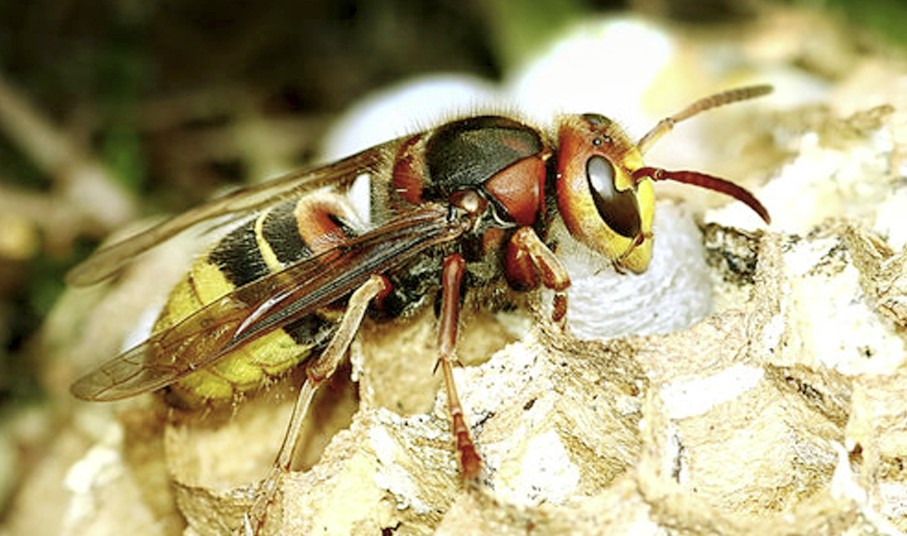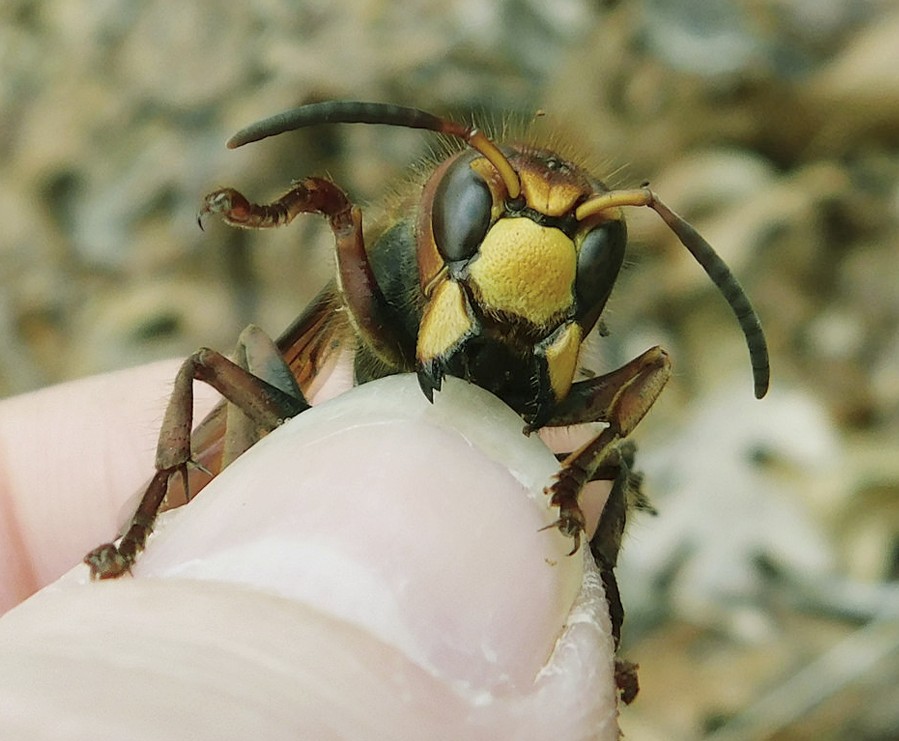European Hornet
A European Hornet is an insect which is the largest eusocial wasp originating and expanding rapidly in North America. The insect was introduced by European settlers, sometime in the 1800s, and is said to be the only true hornet in North America. It has a large body, and now it has become very common in the areas of the eastern US. Moreover, it is moving rapidly towards the west and south.

However, it is hard to find European hornets in urban areas. Forested places, despite the city boundaries, can have a huge number of these insects. Interestingly, there are around 200-300 hornets in just one colony or one nest. Many times, people confuse European hornets with its relative, the yellow jacket wasp. These hornets are least bothered for humans unless their lives and habitats are threatened.
Identification
European hornets have a number of subspecies and can be found in various color morphs. These eusocial wasps somewhere resemble with honeybees but are comparatively larger in size. It has a fearsome appearance but attacks only when their colony is threatened.
Reproductive females (or queens) are larger in size than the male hornets and workers. They have highly indented or C- shaped eyes and three simple eyes. The head also features a robust antenna, which in males (13 segments), is larger than that in females (12 segments). They have two pairs of wings, but it appears that there’s only one. The size of the wing is the same as their body and has a reddish-orange color. The narrow waist abdomen features brown and yellow stripes all over. Because of the stripes, people often mistake it as Asian giant hornet. There’s a lot of difference between the two. European hornet is larger than almost every kind of wasp but is smaller than Asian giant hornet.
Habitat
It is very interesting to know the habitat of European hornets. Ever heard of a paper nest? By paper, we don’t mean the regular craft paper; Hornets are not that artistic though! But the way they build their nest is nonetheless. Just like honeybees, hornets also make a colony in a nest for themselves. They look for an undisturbed, protected spot in the areas like wall void, attics, or barn. However, they prefer hollow trees to build their nest as nothing else can be as protected as well as undisturbed. They use broken twigs or other small wood pieces to build their nest. They break, chew and then use the twigs to build an unprotected shelter for themselves. Then the nest is given a brown papery envelope kind of cover that protects the nest and the colony. These insects are attracted to lights, so you can find them banging at lighted windows at night.
Life cycle of European Hornet
The life cycle of a European hornet is somehow similar to that of yellow jacket wasps and paper wasps. Usually, during the season of spring or at the time of early May, Queens or reproductive female hornets come out of their shelter or hiding in search of protected and undisturbed nesting sites. They prefer hollow trees but void in the walls, or attics also do.
Once the queen gets the nesting site, she begins building the best with wood and saliva. She chews the wood and then uses it to build a nest. After the nest is ready, she lays eggs in the comb or the first cells of the nest. She wants for them to hatch and when they hatch, she decides to raise the primary brood of hornets by feeding nectars and insects to them. The hatched eggs, on becoming mature, turn into workers. The sterile females or workers then begin to hunt, construct nests and take care of brood in order to give complete rest to the queen to just lay eggs.
Till the time of monsoon or about mid-July, male and female hornets are produced. By late November, the whole colony of hornets dies off naturally. All the workers of the colony are dead because of the hard frosts. Is this the end of European hornets? Clearly, no! Pregnant hornets or the future queens have the ability to survive the winter and lay eggs. However, they do not reuse the old nests and the cycle of searching for nesting sites restart in the next May.
European Hornet Diet
We, humans, have a soft corner for sugary food, don’t we? Similarly, despite being carnivorous, European hornets are slightly attracted to any source of sugary food including nectar, juices and even fallen fruit. You can also find them sitting over open containers of soda. These wasps prey on a variety of insects but focus mainly on hunting large insects like dragonflies, grasshoppers, yellow jackets, giant moths, honey bees, beetles and mantises. So indirectly, they help us control pests and make our lives more pleasant. Thus, they can be found around trash cans or in dumpsters as they scavenge there for meat. They even bring these proteins to their nests to feed their larvae. Apart from pests and insects, European hornets also look for honeydew, fruits, and tree sap.
Pictures
Here are some of the pictures of European Hornets:



Locating the Nest of European Hornets
Finding the nest of European hornets is not an easy task. You need to keep calm and have patience. Also, it is important to note that European hornets can sting multiple times and that can be dangerous. So, to avoid European hornet sting, make sure you wear protective clothing while looking for the nest. If a bee suit is not available, thick clothing will do. Once you’re ready with your bee suit, follow the following steps to locate the nest of European hornets.
- Identify the area where you think the nest can be or where you saw European hornets.
- Now place a ripe apple or raw meat outside. This will act as a bait and will attract the hornets. It won’t take too long for them to sit over the food if the nest is nearby.
- Keep an eye on the bait from a distance of a few meters or few yards. Wait for them to arrive at the bait.
- After some time, you may notice the hornets buzzing around the bait. Once this happens, keep a close look at them. They’ll feed on the bait for a while and will leave the place. The best part is that European hornets move directly to their nest after having food. So, after feeding on the bait, they’ll directly move to their nest.
- Now you need to follow the Hornets on their way back to the nest. They fly in a straight line and this can help you follow them. But these wasps are very fast fliers, so you might lose track of them.
- In case you lose track, set another bait, now closer to their nest, and follow the same process until you locate the nest. When you see hundreds of hornets flying around a specific spot, you’ll know that you’ve spotted the nest. Usually, the nests are underground, so wasps will move in and out from a ground opening.
European Hornet Sting
Are you worried of the venom that a European hornet just injected in you? There’s nothing to worry about. The sting of a European hornet is even less dangerous than that of a honey bee. This explains the whole theory, we guess. Yes, that’s true that a European hornet can sting multiple times, but even that will merely cause swelling and redness in the swollen area. The pain can remain for several days, but there’s nothing that can harm you. In case you suffer from infection, you can consult a doctor. So, the next time a European hornet bites you, don’t shout and jump all around your house!
How to Control European Hornets?
When you know there is a nest of European hornets it’s quite obvious that you must be willing to get rid of them. After all, nobody wants a bee nest in or around their house. So, to help you control these hornets, we’ve mentioned the following points:
- Be ready with your protective equipment like bee veil, bee hat, eyewear, gloves, and coveralls. This will protect you from hornet stings.
- Spot the nest of hornets by easy methods or the one that we’ve mentioned above. This will help you treat the nest more effectively.
- Removing the nest is the first but not the final step. For this, it is best to call the experienced professionals. But if you want to treat them yourself, you can use hornet killer sprays.
- If it is not treated completely, the surviving hornets will recreate a neat. The best time to handle the nest is at night. At night, the queens, as well as the worker bees, will be present at the nest and you can treat them all at once.
- Now you can use the spray but make sure to spray as less as possible. The lesser disturbance you create, the more effective it will be. Make sure to clean the home the next day if you spray at home.
We hope we’ve provided you with enough information regarding this slightly harmful, but beautiful creation of God. Now you’ll surely see them in a different way the next time you identify them. Well, let others also know about it and share the information with everybody you know will be interested to learn!
